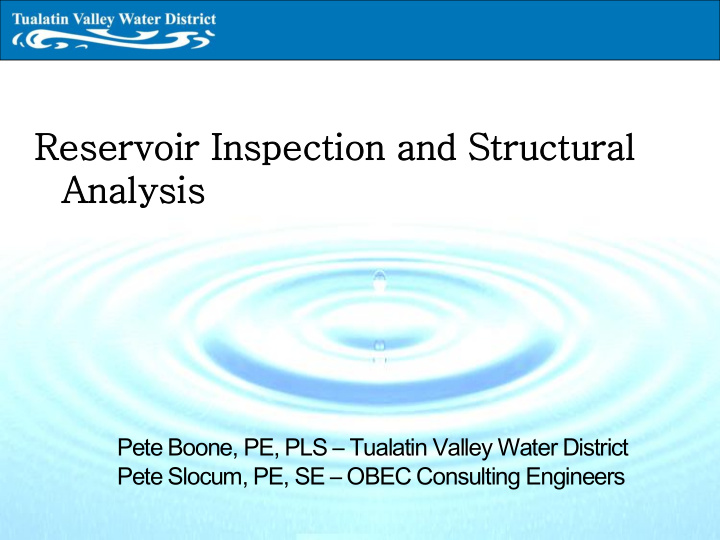



Reservoir In Inspection and Str tructural Analysis is Pete Boone, PE, PLS – Tualatin Valley Water District Pete Slocum, PE, SE – OBEC Consulting Engineers
Why is this import rtant nt? See anything ng?
Co Considerati erations ons wh when planning inspecti ction ons Safety • What are we looking for? • Steel vs. concrete • Interior vs. exterior • How do we get a good look at the roof? •
Safety ety • Confined space entry • Fall hazard • Water hazard
What t are we we looking for? • Steel tanks Paint failures Corrosion Algae • Concrete tanks Cracks and crumbles Exposed rebar Rock pockets • All tanks Ladders Piping Hatches Things that look bad Vents
Interi terior or inspectio tions ns Full Reservoir • Roof inspection by boat Drained reservoir • Wash down walls and floor • Visual inspection from floor
Boat t inspecti ction ons Safety considerations • Lockout/tag out for reservoir valves • Air monitor and radio communication • Retrieval system and harnesses • Lifejackets and second raft deployed • Rescue plan and coordination with local fire dept.
Bo Boat at in inspe pections tions
Boat t inspecti ction ons
Boat t inspecti ction ons
Concret rete e roof configurat guration ons Network of beams and columns
Co Concrete rete roof configurati guration ons Columns and drop panels
Co Concrete rete roof configurati guration ons Columns and drop panels
Co Concrete rete roof inspecti ction ons Looking for cracked, spalled, or crushed concrete
Spalling Beam breaking free of roof slab Spalling from beam/beam pocket friction
Beam and slab cracki king ng Vertical cracks in center from bending Diagonal cracks near ends from shear White stuff is called efflorescence
Beam failure re Beam breaking free of roof slab This began as a shear crack When crack hit longitudinal bars, they peeled free
Be Beam am fa fail ilur ure
De Developin ping g beam failures res
Marki king ng cracks ks in be beams
Ro Roof to wa wall ll connecti ction on
Ro Rock pockets ts in in colu lumns
De Deteriorating riorating concret ete wa wall ll coating ing
Hatches • Hinges • Latches • Locks
Ladders • Corrosion • Attachment
Piping • Corrosion • Attachment
Ex Exterior erior in inspecti ctions ons
Ex Exterior erior in inspecti ctions ons
De Deteriorating riorating pain int
Starting rting a reservoir voir inspecti ction on program am • Safety planning • Gather information – As-builts – Previous inspections • Documentation – Photos – Inspection reports • Evaluation and analysis by structural engineers • Plan for repairs
Pete Slocum, PE, SE Reservoirs – Structural Analysis and Retrofits
Pete Slocum, PE, SE Appropriate Inspection Program In addition to those applicable and mentioned previously by TVWD (Pete Boone) • Nondestructive testing (NDT) • Inspect the Roof • Inspect the Wall • Observation Below Grade • Sample and test Shotcrete
Pete Slocum, PE, SE Appropriate Structural Analysis and Retrofit Strategies Analysis • Analysis of the existing structure • Review available documents • Determine the era of tank construction • Determination of load rating capacity
Pete Slocum, PE, SE Appropriate Structural Analysis and Retrofit Strategies Evaluation • Identification and prioritization of deficiencies and repairs • “Short - term” versus “long - term” repairs and risks • Alternatives for "short-term" repairs • Preliminary cost estimates • Previous loadings
Pete Slocum, PE, SE Appropriate Structural Analysis and Retrofit Strategies (cont’d) • Seismic structural analysis is based on: • Field inspections • Available design, construction, and past inspection report documentation. • Knowledge of construction techniques at the time of construction • Current code • All failure mechanisms
Pete Slocum, PE, SE Understand the Causes • Deterioration • ( don’t just cover it up! ) • Spalled shotcrete cover • Rusty, deteriorated & broken wrap wire • Concrete carbonation • Leakage & freeze/thaw damage at wall top
Pete Slocum, PE, SE What a Water District needs to know about Seismic Loads on your Reservoir • Tank, anchorage and foundation under distress. • Possible failures: anchorage breakage, buckling, pipe connections and soil liquidfaction. • Older reservoirs are undercapacity for the current Code levels. • Taller, narrower tanks have more issues. • All nonstructural features need bracing. • Install shut-off valves. • Locate all ponds and basins down slope from tank. • Earthquake levels: 2% probability of being exceeded in 50 years. • Seismic Slosh and Required Freeboard.
Pete Slocum, PE, SE Also Consider… • Decisions must include non- seismic considerations and life-cycle costs • Piping connections, soil capacity, anchorages, design codes, size . • Economical ways to reduce load and deterioration
Pete Slocum, PE, SE Geotechnical Considerations Site specific information is necessary to accurately identify the true vulnerability including • landslide potential, liquefaction of the soils • ground rupture (based on proximity of the closest mapped fault) • stability of the site.
Pete Slocum, PE, SE Repair Examples
Pete Slocum, PE, SE Corrective Measures Epoxy Injection
Pete Slocum, PE, SE Corrective Measures External Stirrups
Pete Slocum, PE, SE Corrective Measures External Stirrups
Pete Slocum, PE, SE Corrective Measures Scaffolding Support
Pete Slocum, PE, SE Questions?
Co Contact act Inform ormation ation Pete Boone, PE, PLS Engineer Tualatin Valley Water District 503-848-3054 peteb@tvwd.org Pete Slocum, PE Project Manager/Sr. Project Engineer OBEC Consulting Engineers 541-683-6090 PSlocum@obec.com
Recommend
More recommend